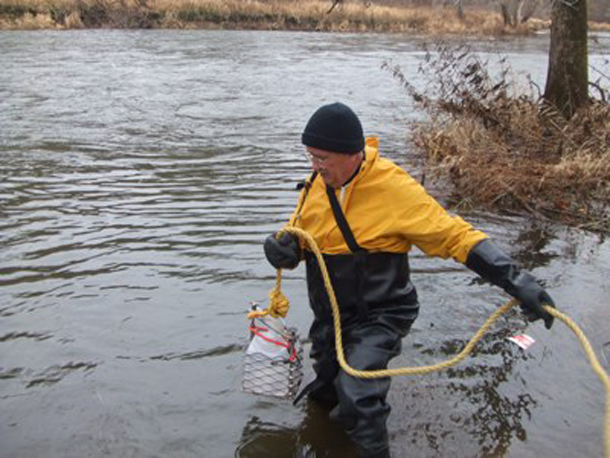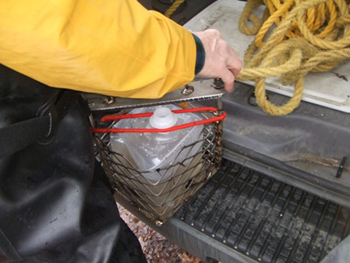Disposal of Fracking Wastewater Polluting PA Rivers
Published: February 6, 2018

(stream/download) as an MP3 file
Bromide has been found in rivers in Pennsylvania and scientists are scrambling to find out whether it’s associated with hydraulic fracturing of the Marcellus Shale.
GELLERMAN: It’s Living on Earth, I'm Bruce Gellerman.Until last March there had never been an earthquake recorded near Youngstown, Ohio. But since then there have been 11- the last one on New Year’s Eve. The epicenter was near an injection well used by gas drillers to dump millions of gallons of wastewater from hydro-fracking - much of it from nearby Pennsylvania’s gas-rich shale deposits.
Did the disposal of the fracking waste cause the Ohio quakes? Well, the jury is still out, but the polluted fracking water is filled with chemicals and it is extremely salty - 5 times saltier than seawater. Before they began pumping Pennsylvania’s fracking waste into Ohio wells much of it ended up in rivers and streams, and posed a risk to drinking water.
Pennsylvania officials thought they solved the problem when they banned fracking water from treatment plants, but that didn’t work. Reid Frazier of the radio program The Allegheny Front reports, scientists are now scrambling to find out why not, and what to do about it.
FRAZIER: Frank Blaskovich is standing on a catwalk over a pool of water near the Ohio River. He points at a series of pipes draining into the far end of the pool.
BLASKOVICH: What we're seeing is out of those seven standpipes over there… that's the river water coming in.
FRAZIER: Blaskovich manages the Wheeling, West Virginia, water treatment plant. His job is to take water from the Ohio and make it into safe drinking water for his city of 30,000. But since 2008, the Ohio has been too salty. So he's had to dilute it with groundwater from backup wells. Blaskovich doesn't like doing this because each added step costs money.
BLASKOVICH: The price of water will eventually go up which probably will lead to a possible rate hike.
FRAZIER: But he's blending the river water anyway because it's got high levels of bromide. Bromide is a salt, and by itself it's harmless. But combined with chlorine, at a drinking water plant like this one, it forms chemicals called trihalomethanes. Long term exposure to trihalomethanes increases the risk of bladder and other cancers. Because of high bromide levels in the rivers, Wheeling and dozens of plants in Western Pennsylvania and West Virginia have violated the EPA's limits on trihalomethanes over the last three years.
Bromides come from many places--sea water, coal-fired power plants, and chemicals. But the Ohio's spike in bromide occurred three years ago, and Blaskovich thinks that's no coincidence.
BLASKOVICH: That's when deep drilling for gas sort of took off up in this area of the country.
FRAZIER: Each Marcellus shale gas well produces millions of gallons of salty water. The water is full of bromides, and until recently, drillers in Western Pennsylvania trucked this brine to wastewater plants for disposal. The plants could treat the water for metals and other pollutants, but not bromides. That requires expensive new technology. The plants would simply release the treated water--bromides and all--into rivers and streams.
But after trihalomethane levels started creeping up at drinking water plants, regulators took interest. In March, the EPA expressed concern over Pennsylvania's handling of Marcellus discharge, and a month later, the state's Department of Environmental Protection asked drillers to stop sending wastewater to treatment plants. DEP secretary Mike Krancer said a voluntary program would simply be quicker than making a new rule.
KRANCER: The industry-- and I knew they would--did the responsible thing and complied, so we had compliance in 28 hours instead of 28 months.
FRAZIER: According to DEP records reviewed by The Allegheny Front, the request stopped most, but not all drillers from sending Marcellus shale brine to these plants. After the request was made, some facilities, like the Franklin Brine Treatment plant, south of Erie, saw their oil and gas wastewater shipments drop by 70 percent.
Drillers say they are recycling more of their water now, or sending it to Ohio, where it's injected into deep storage wells. So if drillers are sending much less of their salty water to treatment plants, bromide levels in the rivers should be going down. But, at least this year, that hasn't been the case. Jeanne Van Briesen is a Carnegie Mellon scientist who's monitored bromide on the Monongahela River for the past two years.
VAN BRIESEN: We thought in such a wet year, we would see almost no bromide, it would be below our detection limit in most of our samples, and it was not.
FRAZIER: But the question remains, where is the bromide coming from? Answering this question has been a mission for Stanley States.
[SOUND OF A CAR DOOR SLAMMING SHUT]
FRAZIER: States is director of water treatment at Pittsburgh Water and Sewer Authority.
STATES: Yeah, we're here monthly and we're getting close to having full year's worth of data now.
|
|
FRAZIER: He and another water authority scientist are testing bromide levels on a chilly November day. He's on the banks of the Clarion River, in Elk County. States slips on a black and yellow dry suit and gets into the water.
FRAZIER: Into the current, he hurls what looks like a wire milk crate with a plastic jug inside.
[SPLASHING SOUND]
FRAZIER: This is how he collects his water sample. He's here because the water in the Clarion ends up at his plant's intake about 100 miles south on the Allegheny River.
STATES: Source-water protection is part of what we're supposed to do as drinking water people; our treatment doesn't begin at the plant, it begins up in the river system.
FRAZIER: States has been working with University of Pittsburgh researchers to identify bromide hot spots. They've sampled above and below places like municipal and commercial treatment plants that have taken Marcellus Brine in the past. Back in his office, he says coal-fired power plants can raise bromide levels. But he found these aren't the biggest bromide producers.
STATES: It's pretty clear the only places where there’s significant increases in bromides are downstream of these industrial waste water plants.
FRAZIER: Krancer, the DEP secretary, says it's probably too early to declare an on-going bromide problem in the rivers. But assuming the data are accurate, and that bromide levels are still high - does it mean that Marcellus brine is still the cause?
That is unclear, says Carnegie Mellon's van Briesen. She says there could be other potential sources of bromide. These include wastewater from conventional oil and gas drilling--the kind that's been produced in Pennsylvania for decades.
VAN BRIESEN: So, almost anything to do with fossil fuel production has the potential to contain amounts of bromide we should manage and think about.
FRAZIER: So does this mean that water from hydraulic fracturing wasn't really a problem in the first place? That's what some plant operators are saying. One of these operators is Paul Hart, who owns three oil and gas wastewater treatment plants. Hart declined to speak on tape for this story. But off the air he said DEP used "bad science" in asking drillers to steer clear of his plant. But Van Briesen, of Carnegie Mellon, disagrees.
VAN BRIESEN: We know this wastewater has bromide in it. Any waste you take out of the system that contains bromide will reduce amount of bromide in the basin.
FRAZIER: In the spring, the EPA will tighten its standards for trihalomethanes--those carcinogens formed by bromides that end up in drinking water. That has water plant operators, like States, worried.
STATES: And the public will be very upset if they have to receive public notification that their water doesn't comply with the safe drinking water act. They're going to want answers.
FRAZIER: Chief among their questions, States says, is who's responsible for getting bromides out of the rivers. For Living on Earth, I'm Reid Frazier.
GELLERMAN: Ann Murray of The Allegheny Front helped report our story.
Back to Living on Earth
Living on Earth wants to hear from you!
Living on Earth
62 Calef Highway, Suite 212
Lee, NH 03861
Telephone: 617-287-4121
E-mail: comments@loe.org
Newsletter [Click here]
Donate to Living on Earth!
Living on Earth is an independent media program and relies entirely on contributions from listeners and institutions supporting public service. Please donate now to preserve an independent environmental voice.
NewsletterLiving on Earth offers a weekly delivery of the show's rundown to your mailbox. Sign up for our newsletter today!
 Sailors For The Sea: Be the change you want to sea.
Sailors For The Sea: Be the change you want to sea.
 The Grantham Foundation for the Protection of the Environment: Committed to protecting and improving the health of the global environment.
The Grantham Foundation for the Protection of the Environment: Committed to protecting and improving the health of the global environment.
 Contribute to Living on Earth and receive, as our gift to you, an archival print of one of Mark Seth Lender's extraordinary wildlife photographs. Follow the link to see Mark's current collection of photographs.
Contribute to Living on Earth and receive, as our gift to you, an archival print of one of Mark Seth Lender's extraordinary wildlife photographs. Follow the link to see Mark's current collection of photographs.
 Buy a signed copy of Mark Seth Lender's book Smeagull the Seagull & support Living on Earth
Buy a signed copy of Mark Seth Lender's book Smeagull the Seagull & support Living on Earth


